Background
As a novice in software, I am currently aiming to format my camerapreview to full screen, that would be identical to the camera preview on Snapchat. Right now, I am able to showcase my camera preview in a 1:1 box format that I was able to set by following this tutorial. Other potential solutions that I had encountered in other questions either stretched/distorted the previewed image, or didn't launch the application altogether. How would I be able to do this while still maintaining portrait mode? Code provided below
Additional device specifications include the fact that the device I aim to launch the application on is a OnePlus Six, and its aspect ratio is 19:9. This is what the camera on my application currently looks like this.
I want to eliminate the black borders above and below the preview and allow the camera to take up the entirety of the screen.
MainActivity.java
package com.example.cv;
import androidx.annotation.NonNull;
import androidx.appcompat.app.AppCompatActivity;
import androidx.core.app.ActivityCompat;
import androidx.core.content.ContextCompat;
import android.Manifest;
import android.content.pm.PackageManager;
import android.opengl.Matrix;
import android.os.Bundle;
import android.util.Log;
import android.view.SurfaceView;
import android.view.WindowManager;
import android.widget.Toast;
import org.opencv.android.BaseLoaderCallback;
import org.opencv.android.CameraBridgeViewBase;
import org.opencv.android.JavaCameraView;
import org.opencv.android.OpenCVLoader;
import org.opencv.core.Core;
import org.opencv.core.CvType;
import org.opencv.core.Mat;
import org.opencv.imgproc.Imgproc;
public class MainActivity extends AppCompatActivity implements CameraBridgeViewBase.CvCameraViewListener2
{
private static String TAG = "MainActivity";
JavaCameraView javaCameraView;
Mat mRGBA, mRGBAT, dst;
private static final int MY_CAMERA_REQUEST_CODE = 100;
BaseLoaderCallback baseLoaderCallback = new BaseLoaderCallback(MainActivity.this) {
@Override
public void onManagerConnected(int status)
{
if (status == BaseLoaderCallback.SUCCESS) {
javaCameraView.enableView();
} else {
super.onManagerConnected(status);
}
}
};
static
{
if (OpenCVLoader.initDebug())
{
Log.d(TAG, "OpenCV is Configured or Connected successfully.");
}
else
{
Log.d(TAG, "OpenCV not Working or Loaded.");
}
}
@Override
protected void onCreate(Bundle savedInstanceState)
{
super.onCreate(savedInstanceState);
setContentView(R.layout.activity_main);
javaCameraView = (JavaCameraView) findViewById(R.id.my_camera_view);
if (ContextCompat.checkSelfPermission(this, Manifest.permission.CAMERA)
== PackageManager.PERMISSION_GRANTED) {
Log.d(TAG, "Permissions granted");
javaCameraView.setCameraPermissionGranted();
javaCameraView.setCameraIndex(CameraBridgeViewBase.CAMERA_ID_BACK);
javaCameraView.setVisibility(CameraBridgeViewBase.VISIBLE);
javaCameraView.setCvCameraViewListener(this);
} else {
Log.d(TAG, "Permission prompt");
ActivityCompat.requestPermissions(this, new String[]{Manifest.permission.CAMERA}, MY_CAMERA_REQUEST_CODE);
}
}
@Override
public void onCameraViewStarted(int width, int height)
{
mRGBAT = new Mat();
dst = new Mat();
}
@Override
public void onCameraViewStopped()
{
mRGBA.release();
}
@Override
public Mat onCameraFrame(CameraBridgeViewBase.CvCameraViewFrame inputFrame)
{
mRGBA = inputFrame.rgba();
Core.transpose(mRGBA, mRGBAT);
Core.flip(mRGBAT, mRGBAT, 1);
Imgproc.resize(mRGBAT, dst, mRGBA.size());
mRGBA.release();
mRGBAT.release();
return dst;
}
@Override
public void onPointerCaptureChanged(boolean hasCapture) {
}
@Override
protected void onDestroy() {
super.onDestroy();
if (javaCameraView != null)
{
javaCameraView.disableView();
}
}
@Override
protected void onPause() {
super.onPause();
if (javaCameraView != null)
{
javaCameraView.disableView();
}
}
@Override
protected void onResume() {
super.onResume();
if (OpenCVLoader.initDebug())
{
Log.d(TAG, "OpenCV is Configured or Connected successfully.");
baseLoaderCallback.onManagerConnected(BaseLoaderCallback.SUCCESS);
}
else
{
Log.d(TAG, "OpenCV not Working or Loaded.");
OpenCVLoader.initAsync(OpenCVLoader.OPENCV_VERSION, this, baseLoaderCallback);
}
}
@Override
public void onRequestPermissionsResult(int requestCode, @NonNull String[] permissions, @NonNull int[] grantResults) {
super.onRequestPermissionsResult(requestCode, permissions, grantResults);
if (requestCode == MY_CAMERA_REQUEST_CODE) {
// camera can be turned on
Toast.makeText(this, "camera permission granted", Toast.LENGTH_LONG).show();
javaCameraView.setCameraPermissionGranted();
javaCameraView.setCameraIndex(CameraBridgeViewBase.CAMERA_ID_FRONT);
javaCameraView.setVisibility(CameraBridgeViewBase.VISIBLE);
javaCameraView.setCvCameraViewListener(this);
} else {
//camera will stay off
Toast.makeText(this, "camera permission denied", Toast.LENGTH_LONG).show();
}
}
}
activity_main.xml
<?xml version="1.0" encoding="utf-8"?>
<RelativeLayout
xmlns:android="http://schemas.android.com/apk/res/android"
xmlns:app="http://schemas.android.com/apk/res-auto"
xmlns:tools="http://schemas.android.com/tools"
android:layout_width="match_parent"
android:layout_height="match_parent"
tools:context=".MainActivity">
<org.opencv.android.JavaCameraView
android:id="@+id/my_camera_view"
android:layout_width="fill_parent"
android:layout_height="fill_parent"
/>
</RelativeLayout>
AndroidManifest.xml
<?xml version="1.0" encoding="utf-8"?>
<manifest xmlns:android="http://schemas.android.com/apk/res/android"
package="com.example.cv">
<supports-screens android:resizeable="true"
android:smallScreens="true"
android:normalScreens="true"
android:largeScreens="true"
android:anyDensity="true" />
<uses-permission android:name="android.permission.CAMERA"/>
<uses-feature android:name="android.hardware.camera"/>
<uses-feature android:name="android.hardware.camera.autofocus"/>
<uses-feature android:name="android.hardware.camera.front"/>
<uses-feature android:name="android.hardware.camera.front.autofocus"/>
<application
android:allowBackup="true"
android:icon="@mipmap/ic_launcher"
android:label="@string/app_name"
android:roundIcon="@mipmap/ic_launcher_round"
android:supportsRtl="true"
android:theme="@style/Theme.AppCompat.Light.NoActionBar">
<activity android:name=".MainActivity"
android:screenOrientation="portrait"
android:configChanges="keyboardHidden|orientation">
<intent-filter>
<action android:name="android.intent.action.MAIN" />
<category android:name="android.intent.category.LAUNCHER" />
</intent-filter>
</activity>
</application>
</manifest>
UPDATE: I have come across solutions that aim to change orientation and/or eliminate the action bar. Applying setMaxFrameSize() does not work aside from stretching the resolution of the CameraPreview.
Another answer I have seen is getWindow().addFlags(WindowManager.LayoutParams.FLAG_KEEP_SCREEN_ON); which is no longer valid as FLAG_KEEP_SCREEN_ON has been deprecated. If anyone can offer the slightest bit of solution as to how I can fix this, I would be eternally grateful.
UPDATE 2: I have attempted to modify layout_height in my activity_main.xml file, only to have it push the preview further down the screen, while it still retains it's 1:1 box format. Additionally, I have also considered implementing javaCameraView.getLayoutParams().height= in my MainActivity only to have it distort/stretch the camera preview and not achieve my intended desire.
